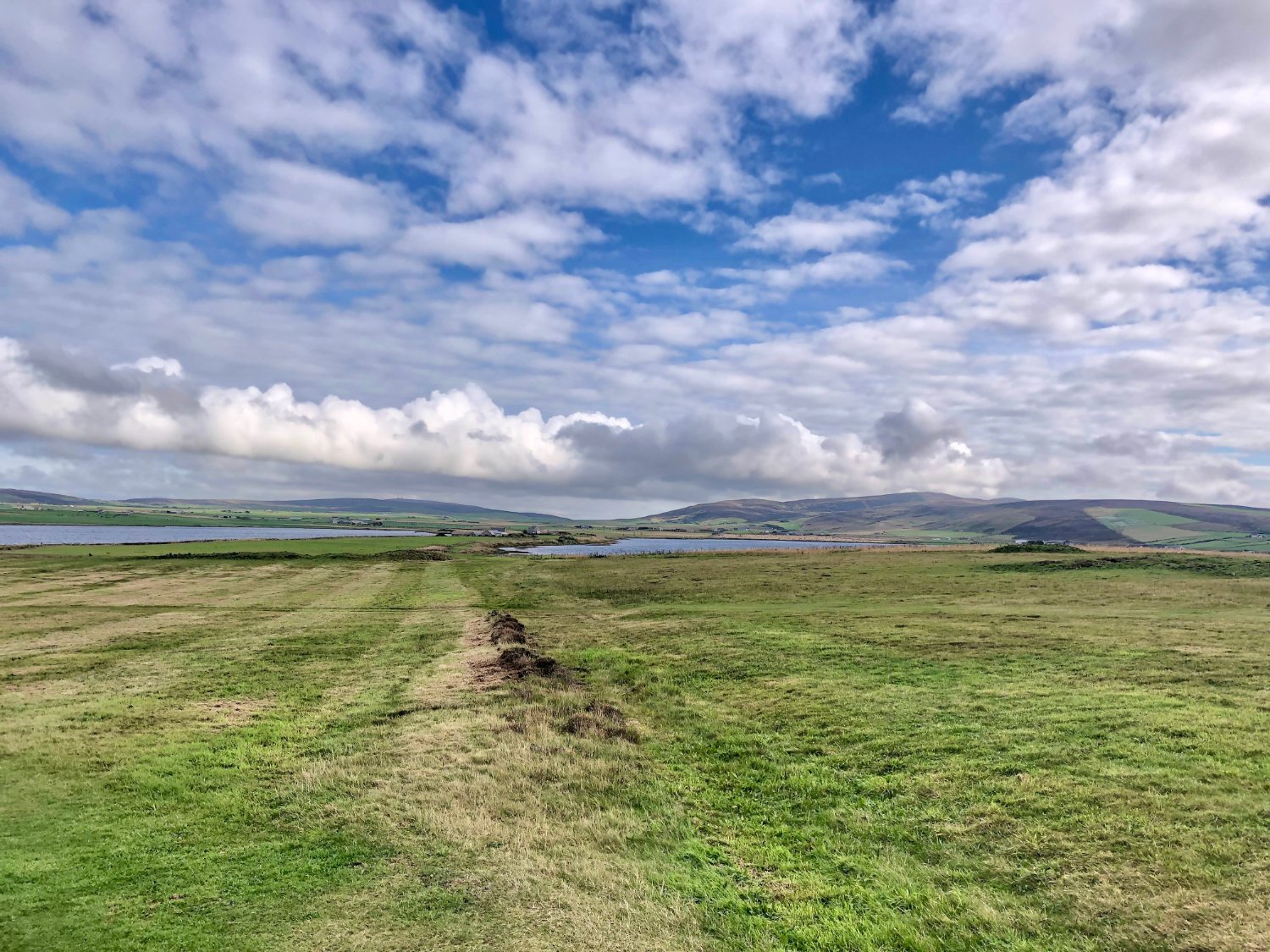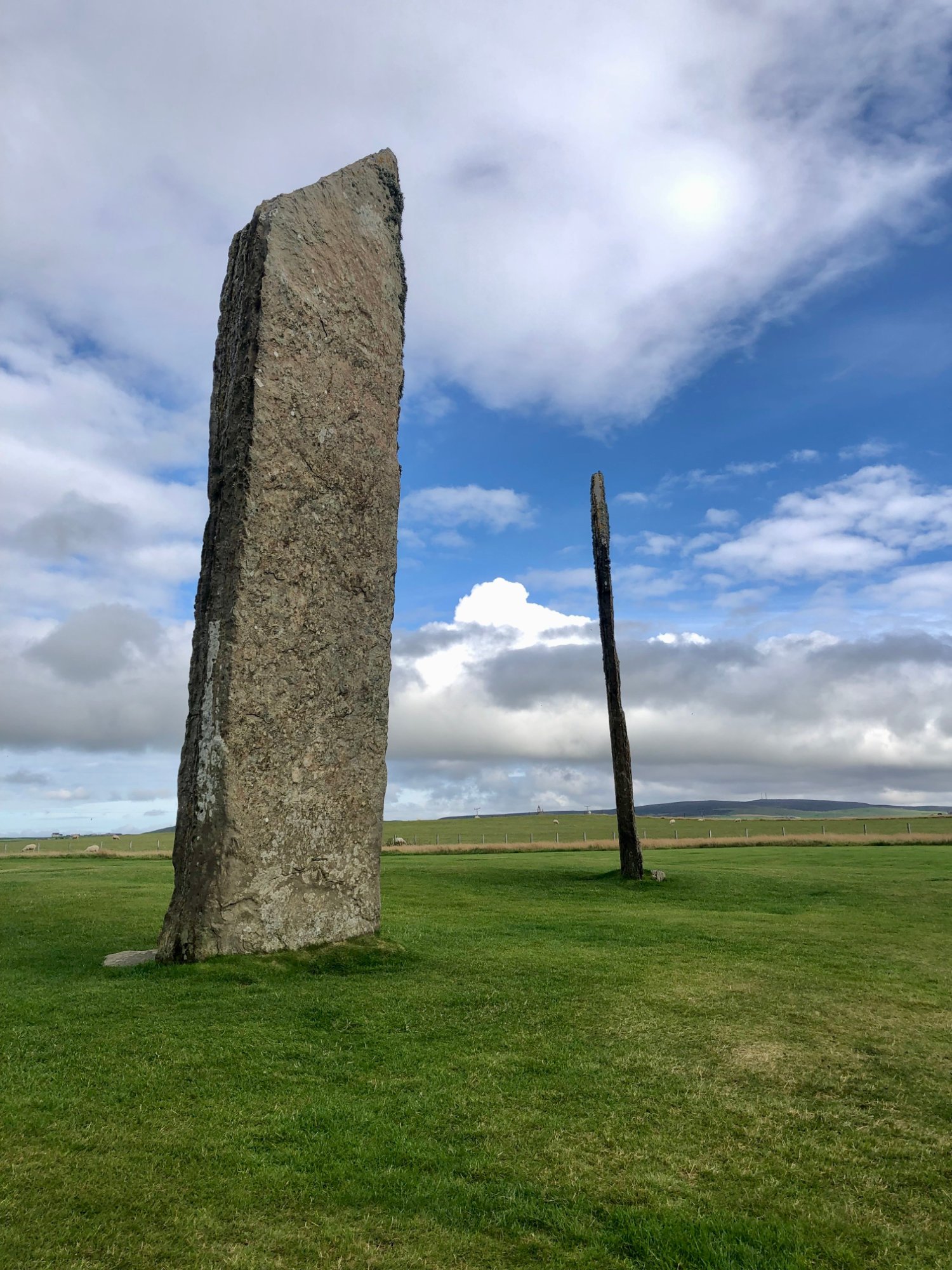142km Orkney - an island tour
Stromness
Ride overview
Islands of energy. Islands of wind, surrounded by bounteous seas. Islands of low hills, no trees, long roads into the wind, lochs and the chilly, grey sea might not appeal on first reading. But. Orkney clears your soul. Opens you up and frees you. Some arrive for a short break and never leave. They come from Derby, Blackpool, London. This is cycling as you may never have known it. Long roads into a stiff wind, with not a hedge, nor wall, or tree for shelter. It rains, there are four seasons in an hour, the light is brilliant and in summer, nearly perpetual. The food, harvested from the bounteous sea, from the rich-soiled land grazed sea-weed eating sheep and grass fed cattle. The roads are made longer by the wind, there is more traffic than you may wish for, but that said all things are relative. A busy road in Orkney is more like a infrequently used B road in England. There are numerous cycling options, enough to keep you riding for duration of your stay. And if nature does not make marvel at its beauty, then perhaps the Neolithic UNESCO World Heritage Sites might; Maeshowe, a neolithic burial mound, the best preserved in all of Britain, formed into the shape of a bosom, into which for several weeks the sun beams onto its deepest recesses. There’s Skara Brae, the most complete neolithic ‘town’ in the the world and the ring of Brodgar, a stone henge of mystery and great beauty. Ride to Stromness, a timeless town with cobbled streets and ancient jetties. Orkney. Come for a week and stay for ever. Ride the outlying islands, ferries are frequent and free for the bike.













Ride practicalities
The route is well signed with the blue background/white bicycle along with some North Sea Cycle Route signs.
START/FINISH: Thurso/Kirkwall DISTANCE: approx. 50km. Distance will depend on whether you ride to Duncansby Head Lighthouse, the most north-easterly part of the mainland and back to Gill’s Bay (20km) The Ferry takes off a further 30km approx. Thus if you ride only to Gill’s Head Ferry and onward to Kirkwall, you’ll only be riding about 50km TOTAL ASCENT:700m TERRAIN AND SURFACES: quiet-ish roads. The road to Kirkwall can be a little busy RECOMMENDED CAFÈS/PUBS/ACCOMMODATION: NEARBY MAINLINE TRAIN SERVICES: Thurso PLACES TO VISIT; Mey; Castle Mey, Lambholm (Orkney); The Italian Chapel, Kirkwall; The Orkney Museum, Bishop’s and Earl’s Palace, St. Magnus Cathedral LINKS TO OTHER RIDES: NSCR, stage 23
FERRIES; North Sea RouteFerry; Pentland Ferries run service from Gill’s Bay, Caithness (on the way to John O’Groats), landing at St. Margaret’s Hope, on Orkney. The other Service is with Northlink Ferries , who run a service from Scrabster, (near Thurso) to Stromness on Orkney.
Ride notes
The route described below, is ideal for those who have arrived at John O’ Groats having ridden up from Dover on the East Coast, or Land’s End on the south-western end of Britain. Having got this far, it would be churlish not to spend at least a couple of days on Orkney, for it is a magical archipelago. For those staying for longer, (highly recommended), this tour is an ideal exploration of the mainland. For more rides on the outlying islands, there are well researched cycle routes to enjoy. If you’ve left your bike at home and flown to Kirkwall, worry not - Orkney has you covered. Details of how to hire a bike on the islands can be found here.
Getting to Orkney is easy with or without a bike. You can ride to John o’Groats from Dover or from Land’s End and take the ferry from Gill’s Head. Trains can deliver you from the south to Thurso, from where a bus takes you to Gill’s Head, or there are ferries direct to Kirkwall from Aberdeen.
The route described below takes you from the ferry terminal at St. Margeret’s Hope, across the Churchill barriers to Kirkwall. From the capital, you ride around the island. Ferries ply the outlying islands there are well researched cycle routes around many of them.
A ‘trompe d’oeil in The Italian Chapel, Orkney
The ferry docks at St. Margaret’s Hope, and you begin the ride northwards to Kirkwall across a series of islands linked by the Churchill barriers. These came about when in October 1939, a German U-boat managed to ‘wengle’ (a Shetland word meaning to twist and turn) into the Home Fleet’s harbour at Scapa Flow and torpedo HMS Royal Oak, which sank with the loss of 834 lives. The First Lord of the Admiralty, Winston Churchill ordered the building of the causeways to block off the eastern approaches to the naval anchorage of Scapa Flow. Much of the physical work was undertaken by the Italian Prisoners of War who were held in a camp on Lamb Holm.It is on Lamb Holm, that you ride past another amazing structure; the Italian Chapel. The Italian POWs transformed a Nissan Hut into a chapel with tremendous skill and artistry, especially considering what little access they had to tools and materials.
The riding across a green and windswept grassy land is on the A960, and there is traffic, perhaps more than you may have anticipated. There are though, good sightlines so overtaking you should not be an issue. Unless you are riding here in the long evenings of mid-summer, lights, certainly a rear one, are a good idea. From September onwards, the nights draw in quickly and by the time the afternoon ferry arrives, you’ve visited the Italian chapel and ridden into Kirkwall, you may find that dusk is approaching.
Orkney
Orkney is always breezy. Mist purples the gentle-sloping hills. Sunlight scatters blazing shards across green pastures. The skies are huge and open as you leave Kirkwall on a stiff uphill towards the open hills. Traffic is present and sometimes fast on the long, open roads but sightlines are good and the Orcadians appear to give cyclists plenty of room as they pass. Gentle hills rise and fall around you, covered in a pattern of walls and pasture. The climate in Neolithic times was warmer than it is today, and the low-lying land gave abundant grain harvests. Today, the hills are mostly green grass supporting a vibrant beef and dairy industry. Trees are rare - the near constant wind and the sea-salt air are not conducive to woods. The roads are ‘heavy’, well surfaced with larger aggregate bound together with tar. The wind will blow. The grass shudders, and above you, the clouds race each other across the sky. Settlements few. Expect to be rained upon, bathed in sunshine, blown around, or ride in absolute calm. There could be hail, thunder, or balmy sunshine all day.
The route takes you to the far north of the mainland, to Birsay. Time it right and you can cross the causeway - you have two hours either side of low tide. The Brough was a Pictish power base, there are puffins (in summer), cliffs, white sand beaches and ruins of former fortresses.
An Orkney road
Riding south, though the ever present sea on one side and the wind-swept hills on the other, you arrive at the Bay of Skrail, whose shore is covered in pebbles wich clunk and chink under your feet, their punk colours wet and shiny; lapis-blue, corn-yellow, hematite-red. Layers of seaweed on the tide line lie like uncombed hair.and beside it, Scara Brae, the five thousand year old town. People were living here in organised communities, building monuments and homes which still stand, before the slabs of of stone were dragged to Stonehenge, or the Giza pyramids. Inside the homes with their interlinking corridors, the furniture is all stone - moveable according to need. There are tables, shelves and beds - the latter very short. Did they sleep sitting up?
Skara Brae
Continuing south on the single track road, you pass the The Ring and Ness of Brodgar and the Stone of Stenness. Each huge, each a mystery, each a place of power and brilliance. Billy Connolly; “for reasons best known to myself, (I) danced naked in the Ring of Brodgar. Why? I just felt like doing it, and the director of the TV show wasn’t going to stand in my way. I started off with a piece to camera, saying, “these stones were placed here in 2500 BC by people we know nothing about, and for reasons we know nothing about. Was it a giant’s board game? Were the symbols used in ancient numerology? Were they of religious significance or a landing strip for intergalatic travellers? Personally I think they are the goalposts for some ancient game, the rules of which are lost. It’s just a very impressive place. And odd exotic, hippie types from Glasgow have been known to come here and perform strange rites. Who knows why? All we can do is soak up the atmosphere. Then I emerged naked and dance around the stones singing ‘On Christmas Day in the Morning”, so as I’d keep rhythm and keep the editors happy”.
Stenness Henge
If you’ve booked ahead for the guided tour at Maeshowe. turn left when you reach the A965. Maeshowe, a ‘chambered Cairn’, was built by Neolithic people to honour and capture the sun moving through the sky. For three weeks either side of the winter solstice, a shaft of winter sunlight from the setting sun beams onto the back wall. For around fifteen minutes, there is a promise that warmth and light will return after the dark, bleak days of winter. The cairn is a marvel of early engineering, a sound proof cocoon, womb-like, its walls built with giant blocks of stone. Maeshowe is often described as a ‘burial mound’, but in truth no one really knows - was it a meeting place, a sacred space, a heavenly observation centre, a temple, a woman’s communal space (as Alice Albinia in ‘The Britannias’ suggests)? Whatever its function, it is thought to have taken over 100,000 man hours to build.
Stromness
Stromness, reached after a few more windy kilometres, would make a fine end-of-day stop. Even an end-of-tour- stop for there is a ferry from the town back to Scrabster on the mainland.. It is a town shaped by the sea; a safe haven since Viking times, a whaling and fishing port. The town is a network of flagstone streets, narrow lanes, piers and slipways. It has a timeless feel to it. Lunch at either the Hamnavoe, or The Ferry Inn is a must.
Unless you have decided to stay in the town you’ll need to re-mount and head back along those wind-buffeted roads roads back to Kirkwall, riding through that un-paralleled brilliance, the lux perpetua - the Orkney evening summer light. Or you stay, take the next day ferry to Hoy and ride.
Every route on this website has been carefully researched as well as ridden. However situations on the ground can change quickly. If you know of changes to this route, or cafes, pubs and the like which you think other cyclists need to know about, feel free to share your thoughts below.
If you enjoyed this guide, why not subscribe to the website so as not to miss other inspirational routes?
wheremywheelsgo.uk is a Feedspot UK Cycling top website






